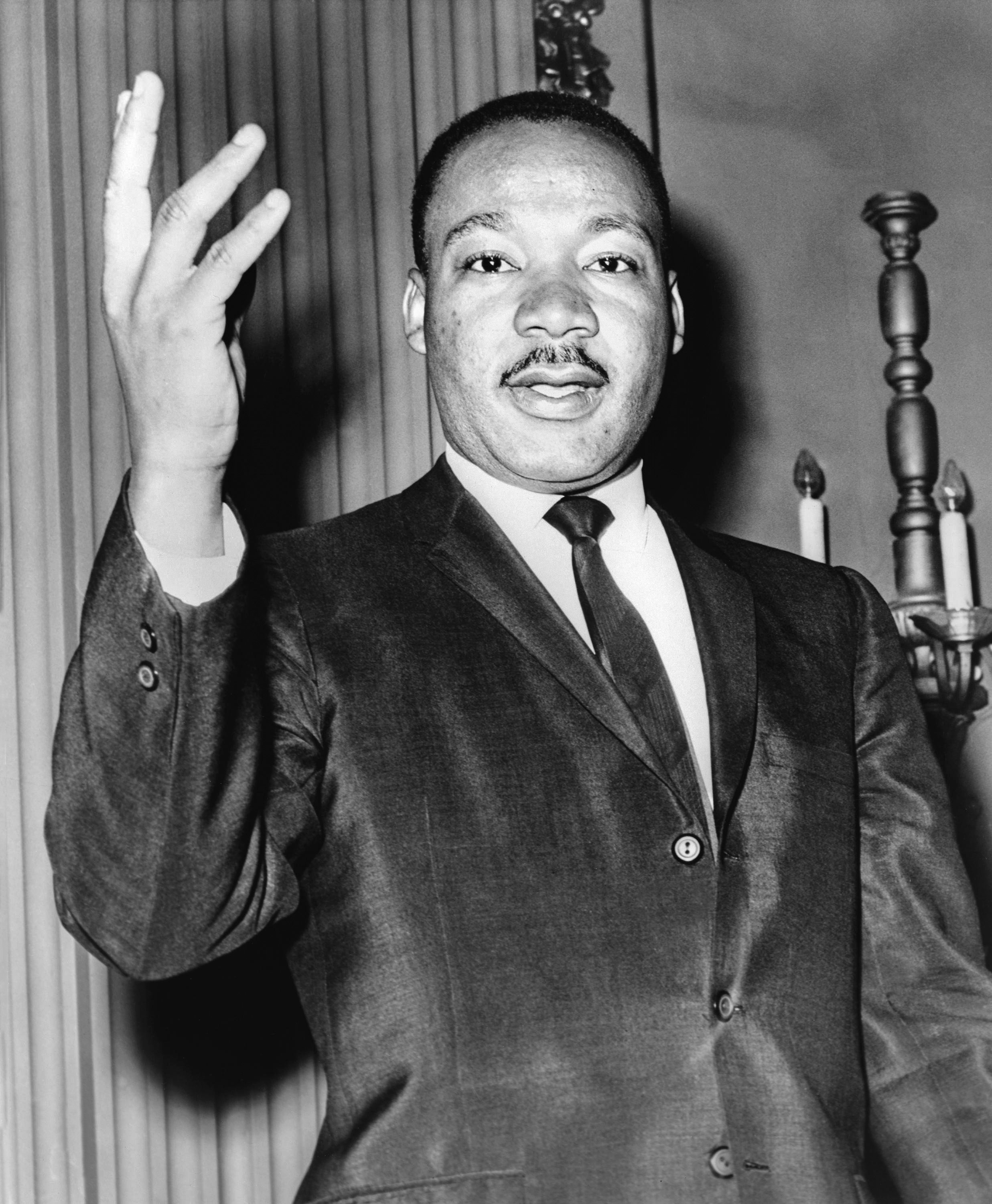Figures from the Movement, National Civil Rights Museum, Memphis

Focus Question: What were the origins, goals, and key events of the Civil Rights Movement?
![]() Cross-Links
Cross-Links
Download free iBook, The Road to Civil Rights from the Academy for Achievement
![]() Race: The Power of an Illusion that explores how race is socially constructed, not genetically based.
Race: The Power of an Illusion that explores how race is socially constructed, not genetically based.
![]() For Lyrics of the Freedom Songs, written and sung at many marches and events from PBS' Soundtrack for a Revolution.
For Lyrics of the Freedom Songs, written and sung at many marches and events from PBS' Soundtrack for a Revolution.
- Click here to listen to some of those songs.
People
B. Martin Luther King, Jr. and Coretta Scott King
C. Thurgood Marshall and Brown v. Board of Education (1954)
D. Rosa Parks
![]() African American Women Activists Before Rosa Parks
African American Women Activists Before Rosa Parks
- Ida B. Wells
- Irene Morgan and Morgan V. Virginia (1946)
- Claudette Colvin and Browder v. Gayle (1956)
E. Malcolm X
F. The Black Panthers
-
Historical Biography: Bayard Rustin, Civil Rights and Gay Rights Activist
![]() 7 Women Civil Rights Leaders You Need to Know
7 Women Civil Rights Leaders You Need to Know
- Ella Baker
- Daisy Bates
- Fannie Lou Hamer
- Dorothy Height
- Dorothy Height published her memoir of the civil rights struggle, Open Wide the Freedom Gates in 2003. Click here to hear the NPR report.
- Diane Nash
- Septima Poinsette Clark
- Jo Ann Robinson
- Claudette Colvin
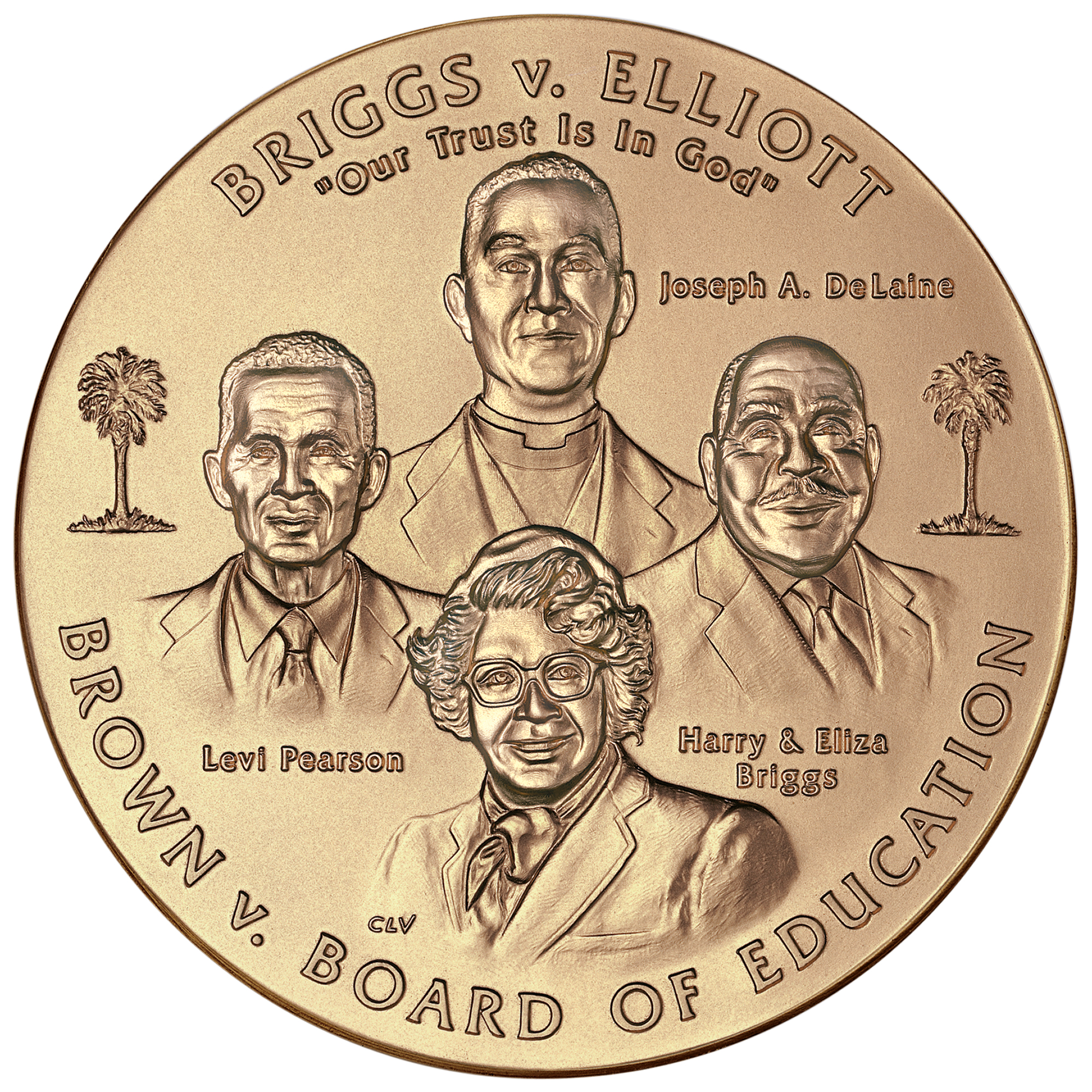
Events
Image to the right shows Congressional Gold Medal, 2003, recognizing Reverend Joseph A. DeLaine, Harry and Eliza Briggs and Levi Pearson.
A. Brown v. Board of Education (1954)
B. The 1955-1956 Montgomery Bus Boycott
-
Browder v. Gayle (1956)
C. The 1957-1958 Little Rock School Crisis
D. The Sit-ins and Freedom Rides of the Early 1960s
E. The 1963 Civil Rights Protest in Birmingham, Alabama
F. The 1963 March on Washington D.C.
G. The 1965 Civil Rights March in Selma, Alabama
H. The 1968 Assassination of Martin Luther King, Jr.
- Influential Literature Page: The Watsons Go To Birmingham, 1963
For a brief slideshow with general information regarding the Civil War and the Civil Rights Movement click here.
People
 For biographies of more than 1000 people, events and organizations associated with civil rights and social justice, see Martin Luther King and the Global Struggle for Freedom.
For biographies of more than 1000 people, events and organizations associated with civil rights and social justice, see Martin Luther King and the Global Struggle for Freedom.
A. Robert Kennedy
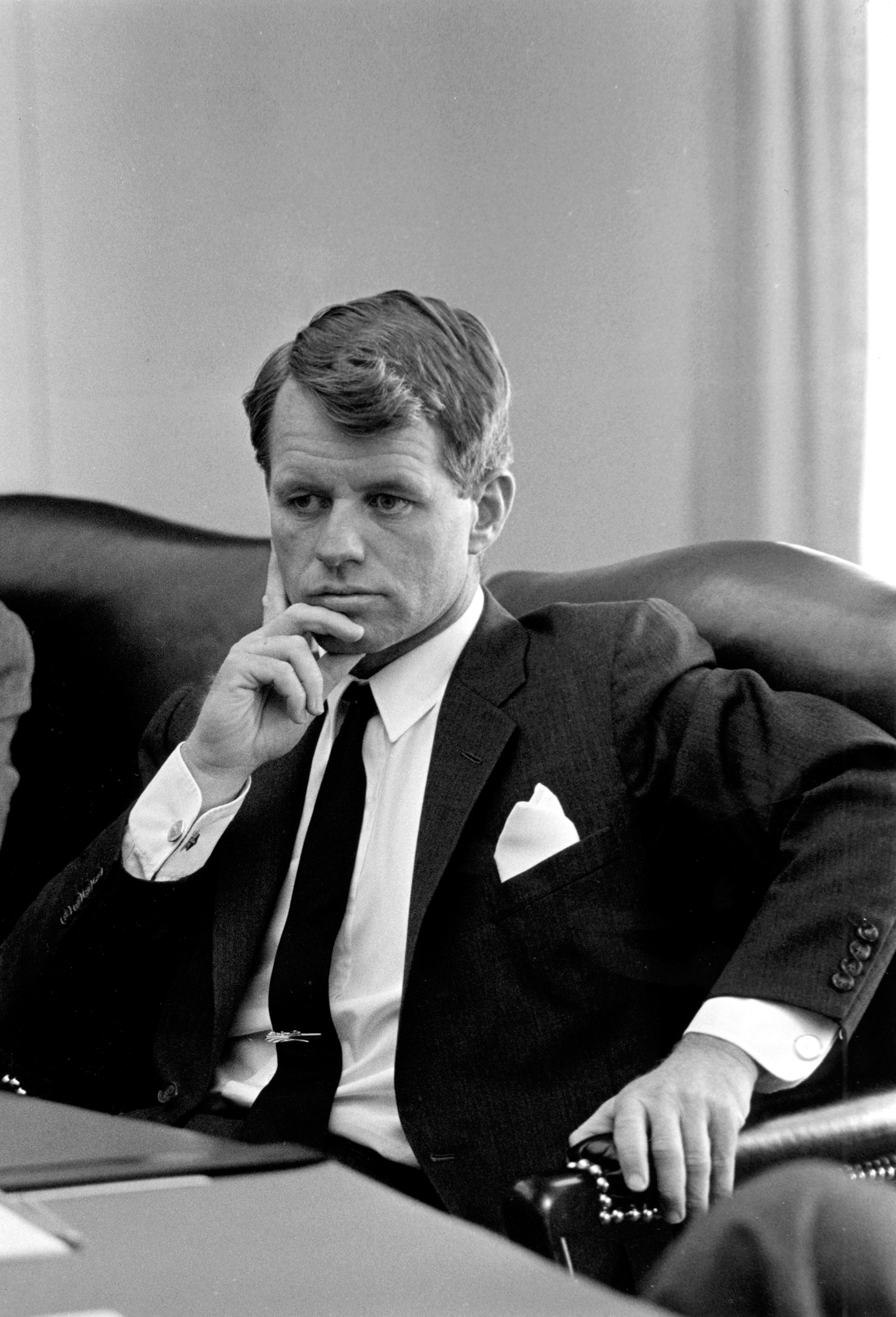 |
| Robert F. Kennedy, Cabinet Room, 1964 |
Robert Kennedy was the brother of President John F. Kennedy. His role in the Civil Rights Movement often goes unnoticed because of other leaders. Kennedy was instrumental in the movement, perhaps being the biggest involvement with the Freedom Rides. He was attorney general at the time.
For more information on the Kennedy administration and their practices during the Civil Rights Movement visit Kennedy and Civil Rights.
Robert Kennedy: Day of Affirmation Speech: audio of Robert Kennedy's 1966 speech to the National Union of South African Students in Cape Town. Speaks about the then-ongoing United States Civil Rights movement.
B. Martin Luther King, Jr. and Coretta Scott King
Dr. Martin Luther King, Jr. is one of the most well-known leaders of the Civil Rights Movement.
- Originally a Baptist minister, he took a leadership role in the 1955 Montgomery Bus Boycott.
- In 1957, he helped found the Southern Christian Leadership Conference, a civil rights organization promoting the use of nonviolent direct action.
- King helped lead the 1963 March on Washington, where he delivered his well-known "I Have a Dream Speech."
- The following year, he received the Nobel Peace Prize for his use of nonviolence to promote civil rights and racial equality. Dr. King was assassinated in 1968.
Interview on the Merv Griffin Show.
Martin Luther King Jr.: The Man and the Dream Documentary on the life of Martin Luther King Jr
Dr. King was the first president of the Southern Leadership Christian Conferences (SCLC) which was responsible for several Civil Rights campaigns. Click here for a video remembering 50 years of the SCLC.
Coretta Scott King, Oct. 2, 2004 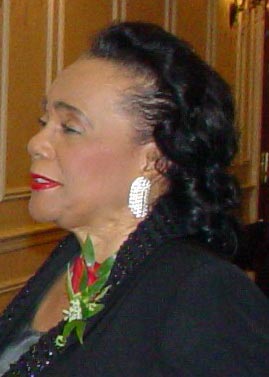
After his assassination, Dr. King's wife, Coretta Scott King, became more prominent as a leader in the Civil Rights Movement. She continued to spread his message of nonviolent protest, founding the Martin Luther King, Jr. Center for Nonviolent Social Change in 1981 in Atlanta.
In the late 1990s, she began to campaign for LGBT equality, citing it as a civil rights issue.
![]() Coretta Scott King's 1996 speech at the Atlanta Gay Pride Festival details King's commitment to LGBT equality.
Coretta Scott King's 1996 speech at the Atlanta Gay Pride Festival details King's commitment to LGBT equality.
The Martin Luther King, Jr. Education and Research Initiative has great resources on Martin Luther King, Jr and the Civil Rights Movement, including lesson plans, and primary and multimedia sources.
The accompanying materials to PBS's film "Citizen King" include maps, timelines, interviews, and footage of Dr. King speaking.![]() Hosted by the Smithsonian Institute, these lesson plans pertain to Martin Luther King, Jr. and nonviolence.
Hosted by the Smithsonian Institute, these lesson plans pertain to Martin Luther King, Jr. and nonviolence.
C. Thurgood Marshall and Brown v. Board of Education (1954)
Thurgood Marshall first came to prominence as one of the most accomplished African-American lawyers in the nation.
- In 1955 he won the landmark victory of Brown v. Board of Education, where the U.S. Supreme Court ruled that public schools must be desegregated.
- This decision reversed the longtime notion of "separate but equal" in public schools which had been the legal doctrine since the 1896 decision in Plessy v. Ferguson.
What Was Brown V. Board of Education? NAACP Legal Fund
Brown v. Board of Education: Landmark Cases for Expanding Civil Rights
- Marshall's success as a lawyer led to his appointment as a federal judge by President John F. Kennedy, and eventually in 1967 he was chosen by President Lyndon Johnson to be the first African American Supreme Court justice.
- He served on the Supreme Court 24 years until 1991, and died in 1993.
- For more information on Thurgood Marshall feel free to visit Thurgood Marshall.
See Marshall's life and accomplishments on this timeline.
For more about Thurgood Marshall, see here.
![]() Equality Speech given by Thurgood Marshall in 1978 regarding the issue of whether or not Black Americans have achieved equality.
Equality Speech given by Thurgood Marshall in 1978 regarding the issue of whether or not Black Americans have achieved equality.
D. Rosa Parks (1913-2005)
 Rosa Parks was a leader in the Civil Rights movement. Her willingness to engage in civil disobedience lead to real advances in African American civil rights, most notably the Montgomery Bus Boycott.
Rosa Parks was a leader in the Civil Rights movement. Her willingness to engage in civil disobedience lead to real advances in African American civil rights, most notably the Montgomery Bus Boycott.
- On December 1, 1955, she famously sat in the front of the bus, which had been reserved for white passengers and refused to give up her seat.
Visit here for a detailed biography of Rosa Parks.
Before the Bus, Rosa Parks Was a Sexual Assault Investigator
- Rosa Parks and Rely Taylor's Brutal Rape: An NAACP Investigation in 1944, The Washington Post (November 27, 2017)
![]() Visit here for the arrest records of Rosa Parks from the National Archives.
Visit here for the arrest records of Rosa Parks from the National Archives.
Rosa Parks Statute; Image by Lieske Leunissen-Ritzen

![]() The Rebellious Lives of Rosa Parks, Zinn Education Project
The Rebellious Lives of Rosa Parks, Zinn Education Project
African American Women Activists Before Rosa Parks
Ida B. Wells and Her Passion for Justice
- The Supreme Court struck down a Virginia law requiring racial segregation on commercial interstate buses
![]()
- Visit here for a lesson plan on the role of civil disobedience today.
- This lesson plan from Scholastic includes resources on Rosa Parks for grades 7-8.
- The lesson plan above relates public policy to Women in the Civil Rights Movement.
Claudette Colvin and Browder v. Gayle (1956)
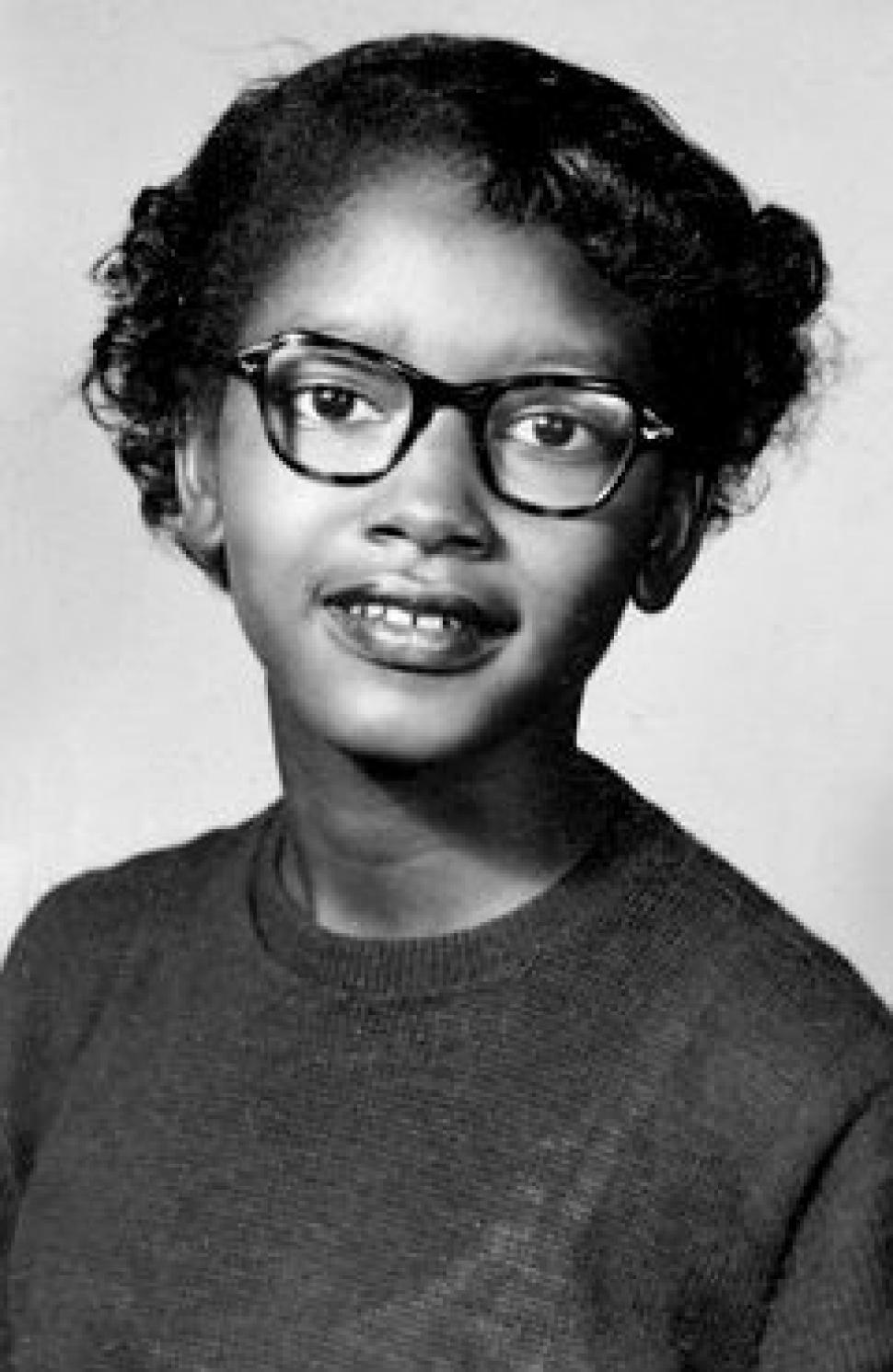
 |
| Image by Urban Intellectuals |
Before Rosa Parks other women refused to give up their seats as well.
- Claudette Colvin , a fifteen-year-old high school student, also refused to give up her seat on a Montgomery, Alabama bus nine months before Rosa Parks.
- She was dragged from the bus and arrested by white police officers.
- Click here to learn about Claudette Colvin and the other women civil rights pioneers.
For more, link to Claudette Colvin: The 15-Year-Old Who Came Before Rosa Parks
- Click here for a rare interview with Claudette Colvin from Democracy now.
- Here is another video of Claudette Colvin talking about her experience during the Civil Rights movement
Browder v. Gayle The Women Before Rosa Parks
![]() Browder v. Gayle Court Decision
Browder v. Gayle Court Decision
- District Court ruled segregation on Alabama’s intrastate buses was unconstitutional
- U.S. Supreme Court had affirmed the District Court’s decision
- On December 17, 1956, the Supreme Court rejected city and state appeals to reconsider their decision in the case, and three days later the order for integrated buses arrived in Montgomery, ending the Montgomery Bus Boycott
E. Malcolm X

Malcolm X was a controversial leader in the Civil Rights movement.
He promoted a message sometimes viewed as contrary to that of Martin Luther King Jr.
Malcolm X was all about equality by any means necessary for African Americans.
He revoked his given name, Malcolm Little, replacing it with X to represent his unknown true slave name. X was a converted Muslim who spent much of his early years of preaching promoting the religion and his mentor, Elijah Muhammed. Malcolm X after his Islamic pilgrimage decided to leave Muhammed and the Nation Of Islam (not the religion itself). He came back and began to preach for equality of all races and not just African Americans.
The Nation of Islam did not take kindly to this and assassinated him on February 21, 1965. His legacy has lasted for decades now and his message his still heard. He is especially well-known for his autobiography, The Autobiography of Malcolm X, which was dictated to writer Alex Haley.
A fantastic website about Malcolm X highlighted by famous quotes of his, testimonials from him, as well as various documentaries about his life, Brother Malcolm.
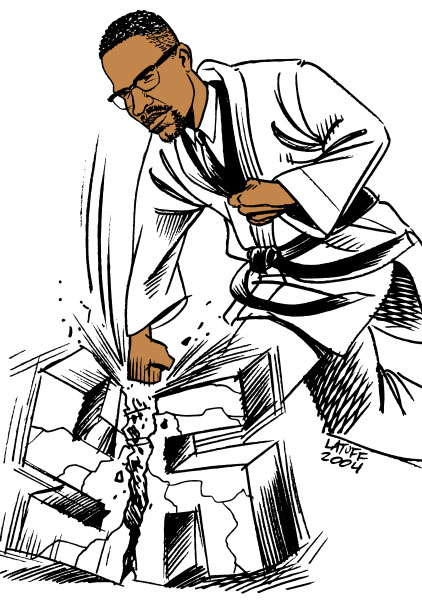 |
| "Malcom X" by Carlos Latuff (2007) |
Quotes from the Autobiography of Malcolm X.
Malcolm X: The Ballot or the Bullet (April 3, 1964)
Multimedia Malcolm X Resources:
A full-length PBS documentary on Malcolm X. Malcolm X Documentary.
Compilation of Malcolm X Speeches and Interviews, 1960-1965.
Malcolm X: 1963 City Desk Interview Famous interview given by Malcolm X in 1963 on the Chicago TV show City Desk. Explains the changing of his name and the rejection of African American "slave names".
F. Black Panthers
1966 witnessed the genesis of the Black Panther Movement. Huey Newton and Bobby Seale integrated the philosophy of Self-Defence for which Malcolm X was famous.
- The Black Panthers were a militant organization against the U.S government, which they perceived as the foundation to blame for social injustice. They fought for radical socialism and social justice against the police.
- Though the party galvanized support from radical socialists and progressives across the nation, the members of the party were targeted and proclaimed enemies to the state due to their "violent" nature.
- J.Edgar Hoover stated in 1969 that the Black Panthers were "the greatest threat to the internal security of the country." Party members like Bobby Hutton, age 17, were targeted and killed by the police.
Click here for the detailed chronology of the Black Panther movement.
The Ten Point Program- or the Black Panther mission statement.
The Rules of the Black Panther Party
The Black Panthers Advocated:
- Marxist Ideology outlined by Malcolm X
- Black citizens arming themselves with guns to protect/defend themselves from police brutality.
- The end to racist police brutality
- Dialectical Materialism
- Equal Rights for Black citizens
- Better housing for black citizens
- Better education for black citizens
Click here to view The Black Power Mixtape 1967 to 1915.
Events
Click here for a complete and detailed chronology of Events from the Civil Rights movement.
A. Brown v. Board of Education (1954)
![]()
Brown v. Board of Education was the decision by the Supreme Court that segregation in schools is unconstitutional.
- The Brown decision overturned Plessy v. Fergusonthathad maintained “separate but equal”—in other words, facilities, including schools, could be segregated as long as they were equal. In reality, however, that equality was never maintained.
- The Chief Justice at the time was Earl Warren, appointed by president Dwight Eisenhower.
- Thurgood Marshall of the NAACP was the prosecuting lawyer.
After the Brown decision, there was much backlash, and, in some school districts, flat out refusal to comply. A year after the Brown decision was made, the court ruled that desegregation did not have to be immediate. Instead, it could be done with “all deliberate speed.” In reality, this meant that school districts could interpret “deliberate speed” in their favor, and many schools were not desegregated for more than two decades.
Separate Is Not Equal: Brown v. Board of Education from the Smithsonian National Museum of American History.
- Brown v. Board of Education: Full text of the decision.
- Visit here for more details on the case.
- To see the documents of the trial Brown v. Board of Education.
- Brown V. Board of Education timeline. See how integration was a slow process and is still a relevant issue today.
Teaching resources for teaching Brown v. Board.
![]() Brown v. Board of Education Re-Enactment
Brown v. Board of Education Re-Enactment
Mendez v. Westminster
See background information on the case Mendez v. Westminster (1947) that provided a state-level precedent for the Brown decision.
- In that case, parents won a federal lawsuit against several California school districts that had segregated Mexican-American schoolchildren.
- For the first time, this case introduced evidence in a court that school segregation harmed minority children
When Family History Overlaps with U.S. history, NPR StoryCorps
 |
| Bus on which Rosa Parks Refused to Give Up Her Seat |
B. Montgomery Bus Boycott, 1955-1956
In December of 1955, Rosa Parks refused to give her seat up to a white person on a segregated bus.
- Many in the black community of Montgomery, lead by prominent professors and ministers including Martin Luther King, had been trying to figure out for a while how to combat or protest racism in the city.
- They thought that the action that Parks had done was the perfect starting point for a wide-scale boycott.
- By the following week, the black community of Montgomery started a bus boycott that lasted for over a year.
- After many negotiations, Montgomery finally ended segregation on their buses.
The boycott was one of the first forums in which blacks fought racism so publicly and on such a large scale. It was also one of the first major political actions of King.
- Out of the boycott, his organization, the Southern Christian Leadership Organization (SCLC) grew, as did his following.
Read about Ralph Abernathy, Dr. King's right-hand man, and an often overlooked, important leader of the Civil Rights Movement.
Published in 1956, this comic book details Martin Luther King, Jr.'s involvement in the Montgomery Bus Boycott.
- Visit here for an interview with Rosa Parks that was aired on the program Democracy Now at the time of her death in 2005.
- Montgomery Bus Boycott Lesson Plan: Includes an activity of a student debate panel.
C. Little Rock School Crisis (1957-1958)
The Little Rock Crisis began in the Fall of 1957 when a high school in Little Rock, Arkansas was supposed to be integrated for the first time.
- During the summer months leading up to the start of school, there was no public protest against this.
- Arkansas Governor Orval Faubus was soon to be up for re-election. While he had never publicly been particularly outspoken against integration or blacks.
- However, he announced, the day before school was to open, that Little Rock would not be able to integrate peacefully. He called in the National Guard to “keep the peace,” although no threat of violence had actually been made.
- On the first day of school, the National Guard, under orders from Faubus, blocked 9 black students from entering school.
- The next day, when the students returned, they were met not only by the National Guard but by protesters shouting racial slurs at them and throwing things at them.
- Racist white supremacist attitudes existed in the community, but they seemed to be inflamed and encouraged by Faubus’ actions. The hatred spread and the crowd of protesters grew to 1,000. Whites from outside of Little Rock came to support the protesters.
- After 20 long days of the students being subject to racial harassment, President Eisenhower sent armed troops to protect their safety. He had finally been forced to make Faubus comply with a Federal order.
- The troops stayed for two months, and Arkansas guards stayed for the rest of the year to ensure safety.
- PBS NewsHour: The Little Rock Nine Fifty Years Later: Interviews with the "Little Rock Nine" fifty years after the events took place.
- The Little Rock Nine, video on YouTube uploaded by Marquette University
Land of (Un)Equal Opportunity: Documenting the Civil Rights Struggle in Arkansas presents documents on other resources on the 1957 Little Rock Central High School integration crisis as well as material on Japanese Internment, women's rights, Freedom Riders and the NAACP.
Read about Daisy Bates who was heavily involved with all steps of the Little Rock Crisis and was with the students every step of the way.
Warriors Don't Cry: Connecting History, Literature and Our Lives, a lesson plan from the Zinn Education Project
D. Sit-ins and Freedom Rides in the Early 1960s
Freedom Rides
The Freedom Riders were civil rights activists who were riding through the South preaching equality.

- At the end of 1960, the supreme court ruled that there could not be segregation on interstate transportation. In other words, a Greyhound bus in New York State, which did not have legal segregation, could not become segregated mid-trip if it was traveling to Georgia.
- Some members of CORE (Congress of Racial Equality) led by James Farmer, were not convinced that this new law would be enforced in the south, so they created the Freedom Rides to test enforcement. The Freedom Rides were modeled after the Journey of Reconciliation, a similar action in 1947.
A racially mixed group of members of CORE, known as the Freedom Riders, boarded two buses in Washington D.C. and planned to travel to New Orleans.
- When the buses reached Alabama, white protesters attacked the Freedom Riders and fire-bombed one of the buses.
- Soon, members of SNCC (Student Nonviolent Coordinating Committee), led by Diane Nash, continued Freedom Rides through out the summer. After they were turned back, they succeeding in arriving in Birmingham, Montgomery, and Jackson. The police would allow mobs, mostly comprised of members of the KKK, 15 minutes to beat the Riders before intervening.
- Once, the Riders arrived in Jackson, they were arrested and brought to Parchman Farm (read about the long and racist history for this prison).
Robert Kennedy initially tried to convince Southern officials to protect these riders, which refused by the governor of Alabama who insisted it was the riders who were the ones creating violence.
- Kennedy then had federal troops ride along with the riders to protect them so they would not get attacked as they already had. The state government arrested over 300 of these riders for stopping in a segregated bus station.
- Kennedy then responded by desegregating all bus and transportation stations; this was very significant because it showed the federal government was in favor of the Civil Rights Movement. See events, letter D, below for more information.
Ultimately, the actions of the Riders pressured the administration to force the Interstate Commerce Commission (ICC) to enforce safety for all travelers. By this time, however, many Freedom Riders had already been seriously injured.
This website from the University of Mary Washington commemorates the 50th anniversary of the Freedom Rides in an interactive exhibit.
The Freedom Riders, Then and Now from Smithsonian Magazine
Sit-ins
Sit-ins are a form of protest in which people peacefully sit in a certain place in an effort to have their issue noticed and changed.
- The first sit-in of the civil rights movement occurred in Greensboro, North Carolina.
- Four black freshmen at A&T university wanted to be served lunch at a lunch counter at Woolworth's department store. They sat in the “white only section,” (the “colored section did not have seating—it was only for take-out).
- They were not arrested like they expected to be, but the were not served either. The day was uneventful, but it launched a powerful movement.
- The next day, the students returned, this time with support from several others who wanted to be served. The press also began to cover the story. They returned for several days, each day with a bigger crowd and more media coverage.
- The Woolworth sit-ins were significant because they inspired hundreds of other sit-ins across the South.
- Many lunch counters became integrated as a result. The sit-ins were also significant because they were started by young people, which inspired young people to get involved in the Civil Rights Movement in greater numbers than in the past.
- Soon after the Woolworths sit-ins, SNCC (Student Nonviolent Coordinating Committee) was formed. This organization was comprised mainly of young people, in contrast to a somewhat older, more moderate SCLC (King’s Southern Christian Leadership Council.)
Here is a link to Teaching Resources on the Greensboro Sit‐Ins: A “Counter Revolution” in North Carolina
Read about Ella Baker, the creator of SNCC and prominent members of many Civil Right's groups. Also, here is a short video explaining her significance, and an interview with her (transcript and audio).
*The Richmond 34 was a group of Virginia Union University students who participated in a nonviolent sit-in at the lunch counter of Thalhimers department store in downtown Richmond, Virginia.
E. Civil Rights Protest in Birmingham (1963)
See Influential Literature Page on the Young Adult Novel, The Watsons Go to Birmingham--1963
Martin Luther King and the Reverend Fred Shuttlesworth were the primary leaders behind the Birmingham Campaign. Eugene “Bull” T. Conner was the mayor of Birmingham. He was an outspoken white supremacist who vowed not to allow integration in his city. Click here for a video about "Bull" Conner and the Birmingham Campaign.
The Birmingham Campaign was especially significant because children participated in unprecedented numbers. They skipped school by the hundreds to participate in the protests. Many adults, who had not previously been active in the movement, were inspired by their actions and joined as well.
The reaction of the police and "Bull" Conner was particularly brutal in these protests. They turned high-pressure water hoses on the protesters, including children. Many northerners and others largely unconnected with the movement were shocked at seeing media images of the hoses turned on the children. This helped the protesters gain national support. Eventually, the protests resulted in integration in Birmingham.
Click here for video from the Campaign, including video of the police turning the water hoses and police dogs onto the protesters.
Click here for an article from the New York Times from May 4, 1963, describing the events of protesters being attacked by police dogs and fire hoses.
 F. March on Washington D.C. (1963)
F. March on Washington D.C. (1963)
In the image to the left: Front row, from left : Whitney M. Young, Jr., Executive Director of the National Urban League; Roy Wilkins, Executive Secretary of the NAACP; A. Philip Randolph, Brotherhood of Sleeping Car Porters, American Federation of Labor (AFL), and a former vice president of the American Federation of Labor and Congress of Industrial Organizations (AFL-CIO); Walter P. Reuther, President, United Auto Workers Union; and Arnold Aronson, Secretary of the Leadership Conference on Civil Rights. August 28, 1964
In the summer of 1963, over 200,000 marched on Washington. The main message of the protesters was to encourage congress to pass a civil rights bill.
Martin Luther King, Jr delivered his famous “I Have A Dream” speech on that day. Click here for an audio recording of Dr. King's speech.
Click text of Dr. King's speech .
Click here for an oral history of the March, 50 years later, from people who were there.
- An article about the 50-year celebration.
- Read about John Lewis, leader of SNCC and prominent Civil Rights leader who gave a speech at the March, remembering the March 50 years later. His speechat the 1963 March.
- Worksheet for students that highlights specific goals of the March on Washington and allows them to think about how and if those goals were met.
In 1964, the Civil Rights Act was passed. It was a landmark civil rights and U.S. labor law that outlaws discrimination based on race, color, religion, sex, or national origin.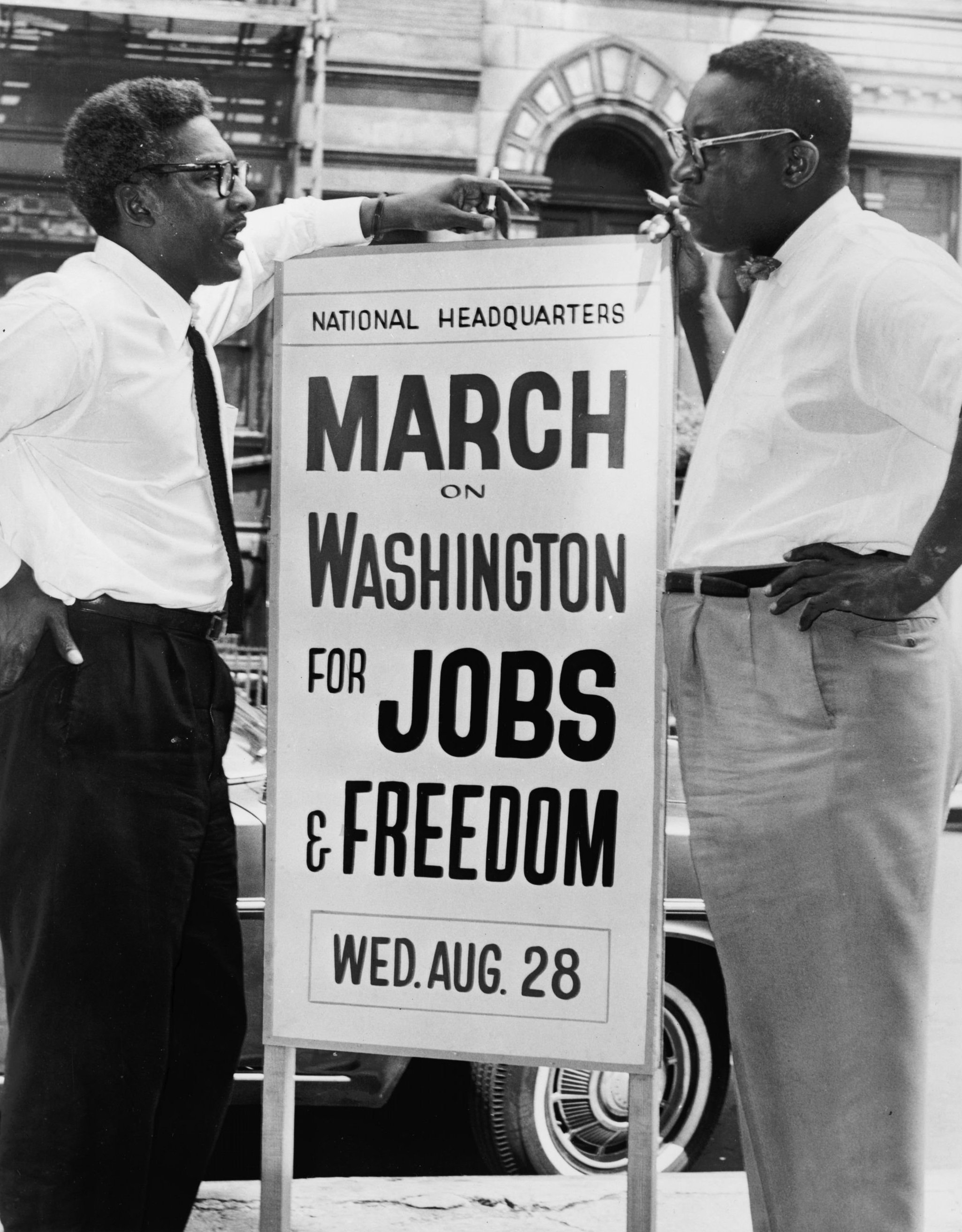
Bayard Rustin (left) and Cleveland Robinson, August 7 1963
Bayard Rustin was one of the key organizers of the March on Washington in 1963, and "perhaps the most critical figure that many people have never heard of" ("The 'Invisible Man' ", Andrew Sullivan, Time, January 20, 2003, p. 41).![]() A lesson plan on The March on Washington and its impact on the Civil Rights Movement.
A lesson plan on The March on Washington and its impact on the Civil Rights Movement.
G. Civil Rights March in Selma, Alabama (1965)
Dr. King helped to orchestrate the protests in Selma, Alabama. In Selma, blacks were a majority but constituted only 3% of the voters. Therefore, voting was a major focus of the protest.
- Click here for video of newsreel footage from the March and text information from history.com.
Read testimony from John Lewis who beaten by Alabama State Troopers on Bloody Sunday.
Click here to see President Lyndon Johnson's speech to Congress on Voting Rights (May 15, 1965) following attacks against Civil Rights protesters in Selma, Alabama.
Click here to check out the Mississippi Burning Trial of 1967.
Teaching about Selma, from the New York Times.
H. Assassination of Martin Luther King, Jr. (1968)
On April 4th, 1968, James Earl Ray shot and killed Dr. King in Memphis, Tennessee.
Article from the International Business Times: Nine Things You May Not Have Known About the Day MLK was Shot
Click here to read about and here to watch riots that occurred following King's murder.
Visit here for Walter Cronkite's report on King's assassination on Youtube.
Click here for the speech that Robert F. Kennedy gave announcing King's assassination.
Additional Resources
Click here for an interactive timeline on race in America.
Click here for the PBS site for "Eyes on the Prize: America's Civil Rights Movement"

